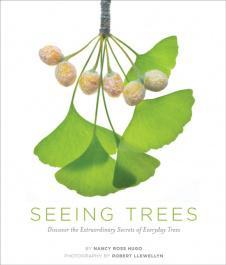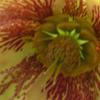
The only way I can describe my reaction to receiving Seeing Trees by Nancy Ross Hugo from Timberpress was like a child being taken into a sweet shop.
Before you even read a word of the book you are completely bowled over by the photography. I have never seen close up of plants with such amazing detail before. The photographs throughout the book are by Robert Llewellyn. I don’t make any pretence of understanding the technical side of things but it appears that Robert took between eight to forty-five images of each subject and with some clever software stitched them together to form almost three-dimensional images, you can see every hair on the leaves. As someone who spends a far bit of time staring closely at plants for my attempts at botanical illustration I am completely enamoured of these images and suspect I will have a go at reproducing some in my art class.
The bonus of this book is that unlike some very photographic productions the words deliver on the same level. Nancy is a complete tree addict and her passion is in understanding how trees work. She studies every element from the structure of the tree right down to the seed leaves of seedlings. She believes that unless we get up close and personal to trees we really do not appreciate their full magnificence, they are not just part of the landscape, “It is always tempting, especially in a broad green landscape to assume that if you can see the entire tree, from bottom of trunk to top of canopy that you have seen it.”
Nancy states “any time you draw something no matter how successful you are from an outside point of view, you learn more about it..” This is because when you look really carefully and train your eye, as I have to with my art, you start to see things you never saw before and this is the whole premise of the book.
Seeing Trees starts with a section which explains how trees work. The language is simple and easy to understand with the biological processes well explained. Nancy’s personality and unique style of writing really brings the subject to life: “Just as human beings have invented brown trucks and bubble wrap to help deliver packages safely trees have developed seed structure to accomplish safe delivery of seeds.”
The book then moves on to look at ten different trees. Being an American book the trees are all American natives but I don’t think this should put non-American readers off since we grow many of them in our gardens. The ten are: American Beech, American Sycamore, Black Walnut, Eastern Red Cedar, Gingko, Red Maple, Southern Magnolia, Tulip Poplar, White Oak and White Pine. Each component of the tree is studied in minute detail but it is far from dry. For example Nancy talks about seeking out and finding American Beech seedlings and her excitement and finally finding some, the efforts made in capturing seedheads at just the right moment or leaves just as they are unfurling.
Seeing Trees initially looks like a typical coffee table book but it isn’t. It contains not only the most amazing photographs I have seen for a very long time but also prose which conveys the author’s enthuiasm for her subject so well that you just want to go out and climb the nearest tree to see what you can find.

